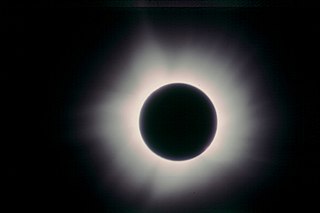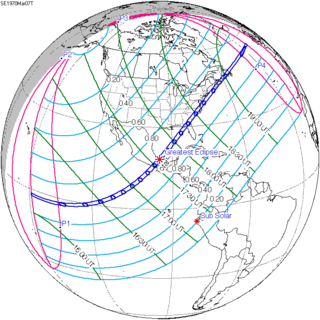
Back Сонечнае зацьменне 7 сакавіка 1970 года Byelorussian Eclipse solar del 7 de marzo de 1970 Spanish خورشیدگرفتگی ۷ مارس ۱۹۷۰ Persian Eclissi solare del 7 marzo 1970 Italian 1970年3月7日の日食 Japanese 1970년 3월 7일 일식 Korean Zonsverduistering van 7 maart 1970 Dutch 1970年3月7日日食 Chinese 1970 nî 3 goe̍h 7 ji̍t sit-ji̍t ZH-MIN-NAN
| Solar eclipse of March 7, 1970 | |
|---|---|
 Totality from Williamston, NC | |
| Type of eclipse | |
| Nature | Total |
| Gamma | 0.4473 |
| Magnitude | 1.0414 |
| Maximum eclipse | |
| Duration | 208 s (3 min 28 s) |
| Coordinates | 18°12′N 94°42′W / 18.2°N 94.7°W |
| Max. width of band | 153 km (95 mi) |
| Times (UTC) | |
| Greatest eclipse | 17:38:30 |
| References | |
| Saros | 139 (27 of 71) |
| Catalog # (SE5000) | 9442 |
A total solar eclipse occurred at the Moon's ascending node of orbit on Saturday, March 7, 1970,[1][2][3][4][5][6] with a magnitude of 1.0414. A solar eclipse occurs when the Moon passes between Earth and the Sun, thereby totally or partly obscuring the image of the Sun for a viewer on Earth. A total solar eclipse occurs when the Moon's apparent diameter is larger than the Sun's, blocking all direct sunlight, turning day into darkness. Totality occurs in a narrow path across Earth's surface, with the partial solar eclipse visible over a surrounding region thousands of kilometres wide. Occurring about 1.3 days after perigee (on March 6, 1970, at 10:30 UTC), this eclipse occurred when the Moon's apparent diameter was larger.[7]
The greatest eclipse occurred over Mexico at 11:38 am CST, with totality lasting 3 minutes and 27.65 seconds. Totality over the U.S. lasted up to 3 minutes and 10 seconds.[8] The media declared Perry as the first municipality in Florida to be in the eclipse direct path.
Inclement weather obstructed the viewing from that location and most of the eclipse path through the remainder of the southern states. There was not an eclipse with a greater duration of totality over the contiguous U.S. until April 8, 2024, a period of 54 years.
Michael C. Blackwell, then a church pastor in Carthage, North Carolina and Wake Forest, North Carolina, was preaching in a seminary in the latter the morning before the eclipse. He and his wife, Catherine, got in the car with neighbor Diane, and Michael drove 30 miles to Johnston County to watch the eclipse, which he later recalled in a 2019 Facebook video as the "most awe-inspiring sight the heavens could possibly offer" and the "most inspiring event of a lifetime."[9]
Totality was visible across southern Mexico and the Gulf of Mexico, Florida, Georgia, South Carolina, North Carolina, Virginia, Maryland, and Nantucket, Massachusetts in the United States, northeast to the Maritimes of eastern Canada, and northern Miquelon-Langlade in the French overseas collectivity of Saint Pierre and Miquelon.[10] A partial eclipse was visible for parts of Hawaii, North America, Central America, the Caribbean, and northern South America.
- ^ "March 7, 1970 Total Solar Eclipse". timeanddate. Retrieved 8 August 2024.
- ^ "Spell cast by eclipse". Spokane Daily Chronicle. (Washington). UPI. March 7, 1970. p. 1.
- ^ "Sun, Moon, Earth fall into step". Free Lance-Star. (Fredericksburg, Virginia). Associated Press. March 7, 1970. p. 1.
- ^ "Scientists get great view of solar eclipse in Mexico". Toledo Blade. (Ohio). Associated Press. March 8, 1970. p. 1.
- ^ "Great shadow crosses Earth as millions watch in awe". Sarasota Herald-Tribune. (Florida). Associated Press. March 8, 1970. p. 1.
- ^ Quigg, H.D. (March 8, 1970). "Seaboard 'oohs' as Ol' Sol blinks". Reading Eagle. (Pennsylvania). UPI. p. 1.
- ^ "Moon Distances for London, United Kingdom, England". timeanddate. Retrieved 8 August 2024.
- ^ Espenak, Fred. "Total Solar Eclipse of 1970 Mar 07". NASA Eclipse Website. Goddard Space Flight Center. Retrieved 3 June 2014.
- ^ "Michael Blackwell recounts March 1970 total solar eclipse". NASA. November 6, 2019.
- ^ Blakeslee, Alton (March 7, 1970). "Total solar eclipse visible in East today". Pittsburgh Post-Gazette. p. 1.
